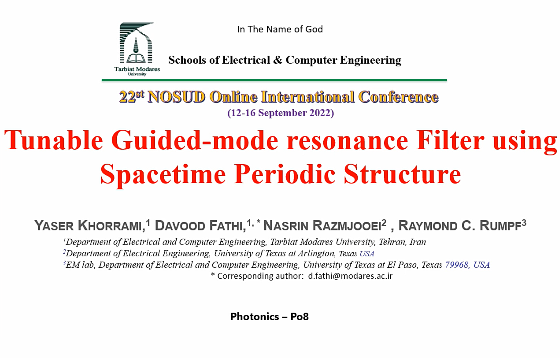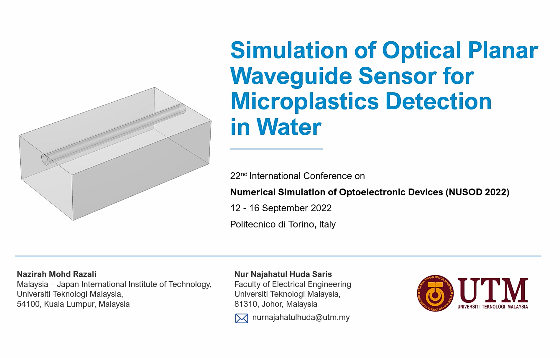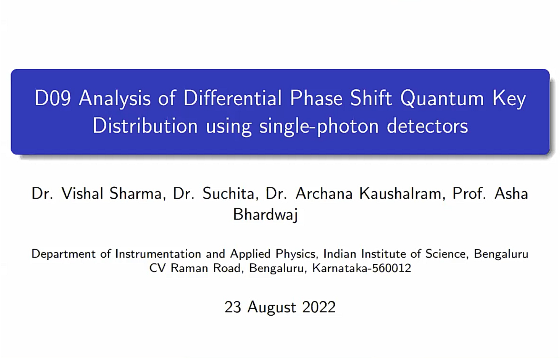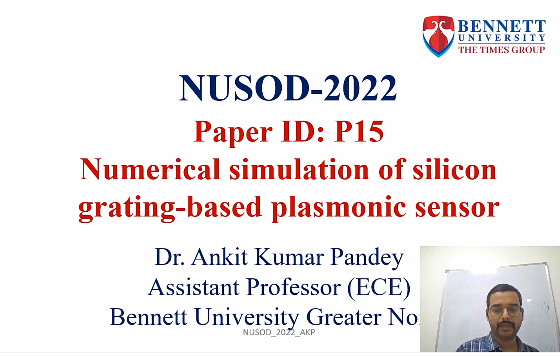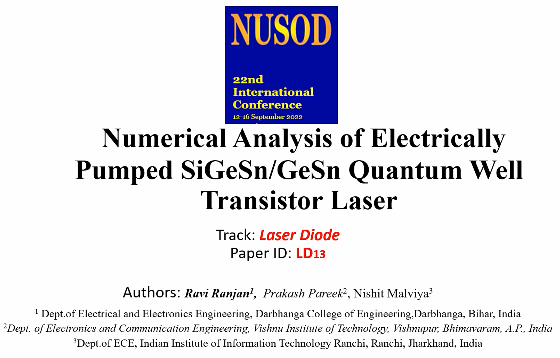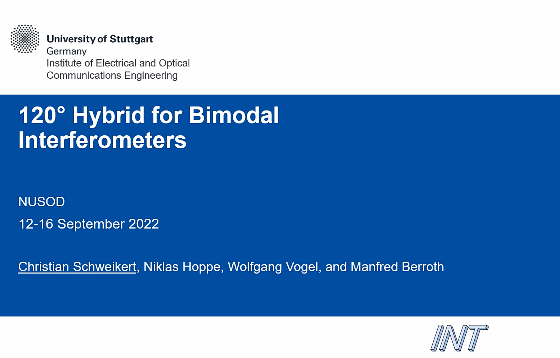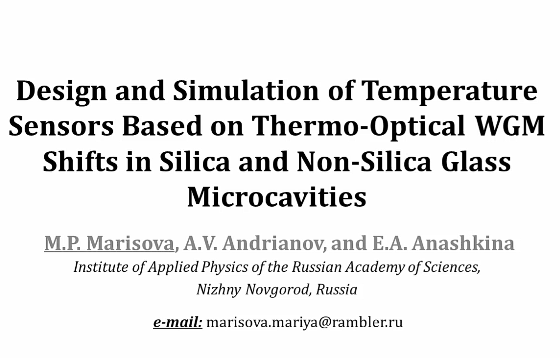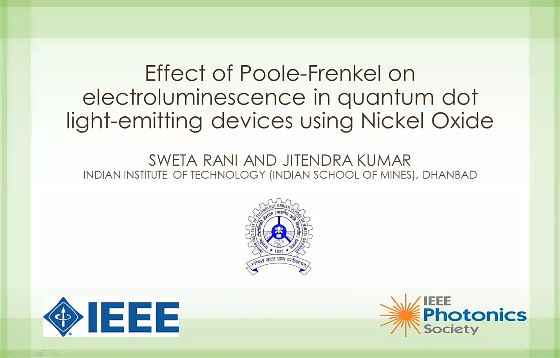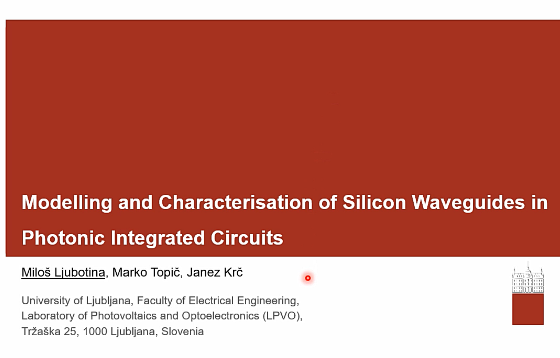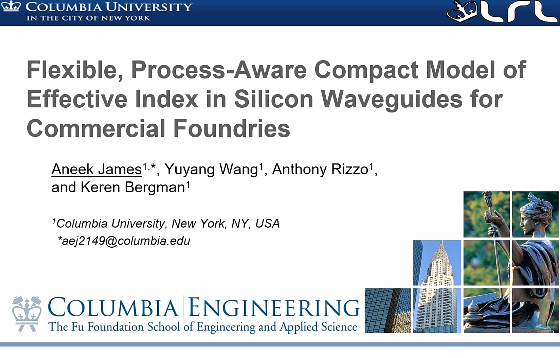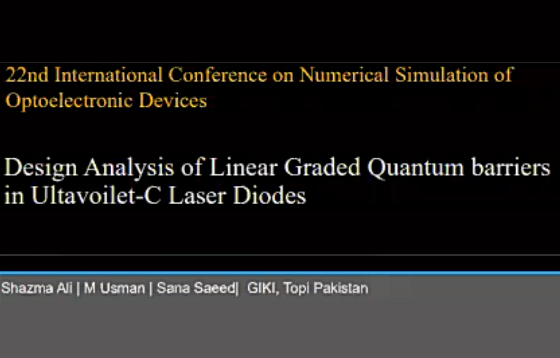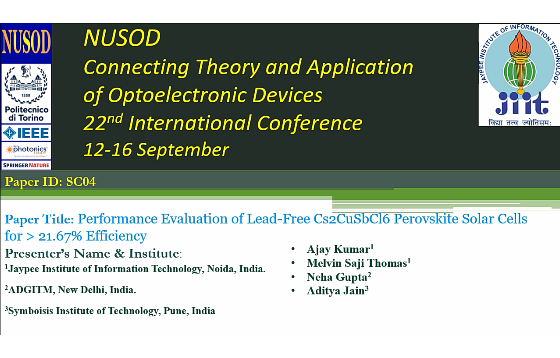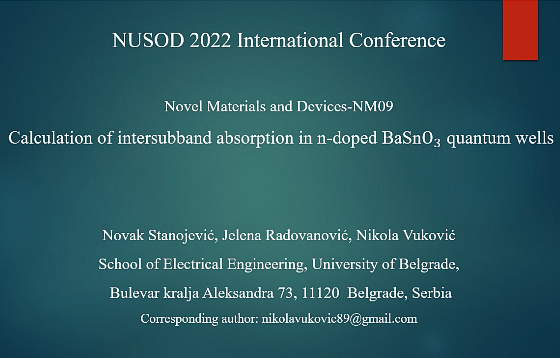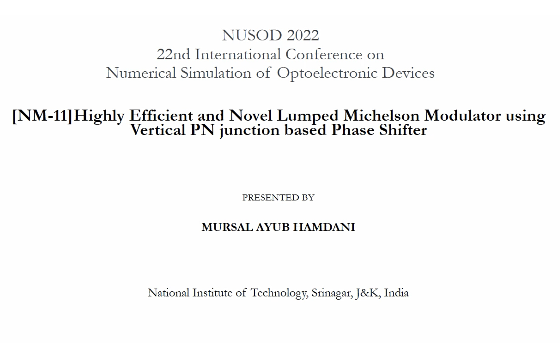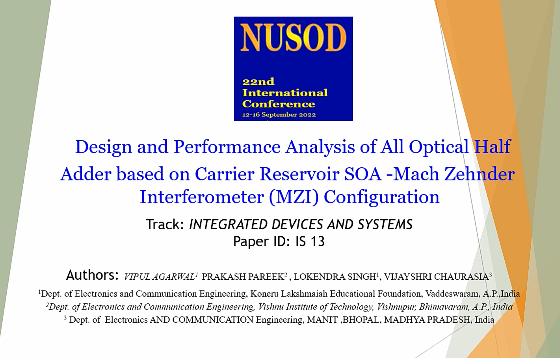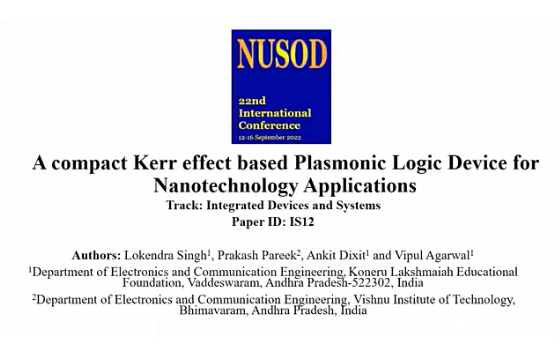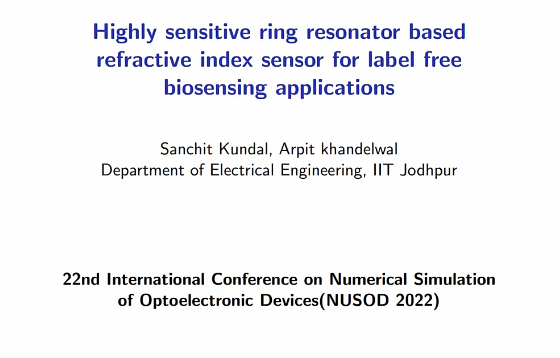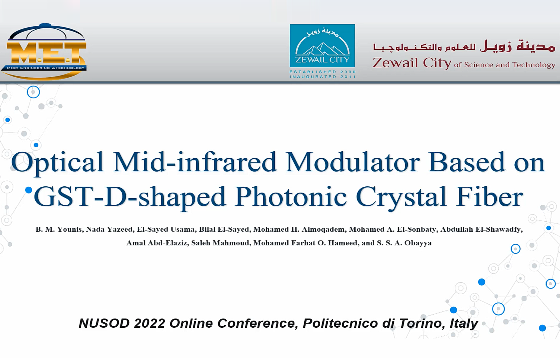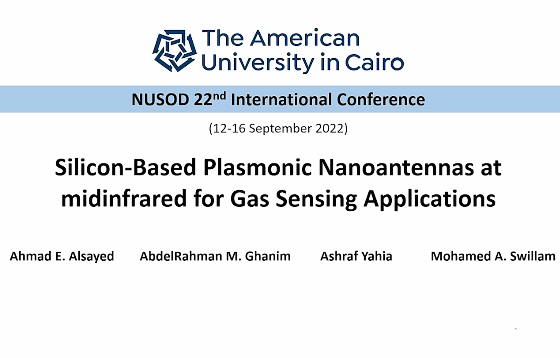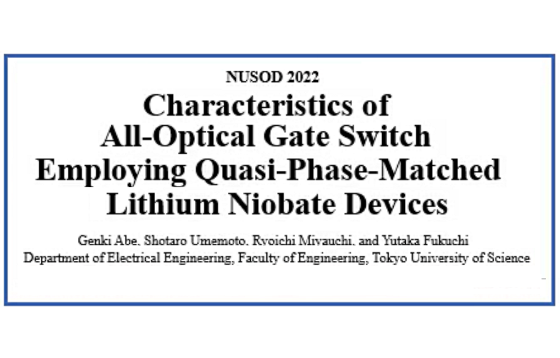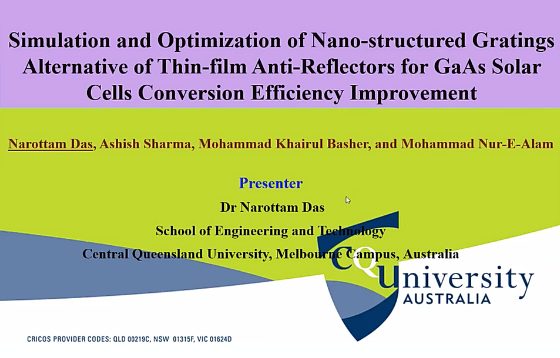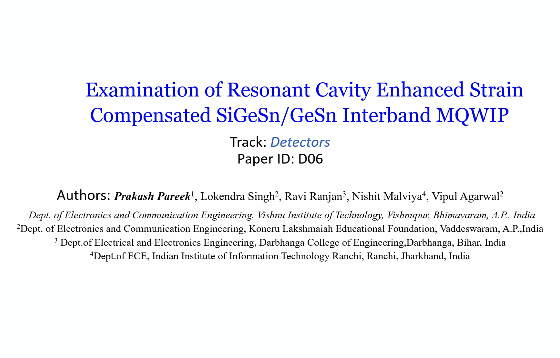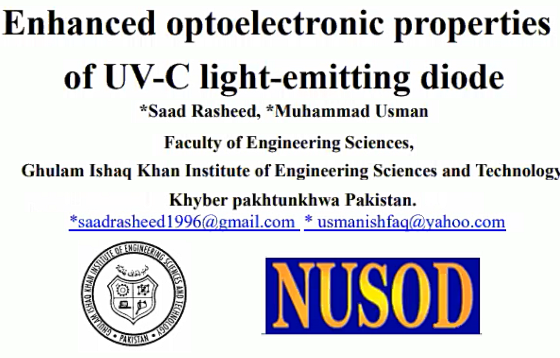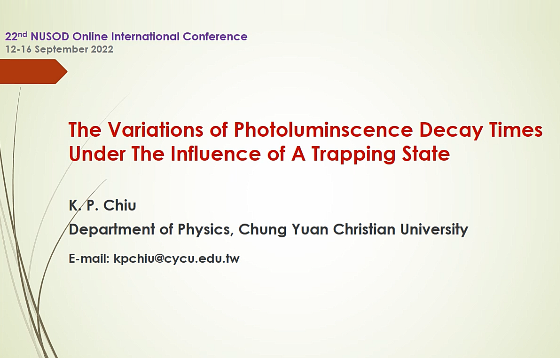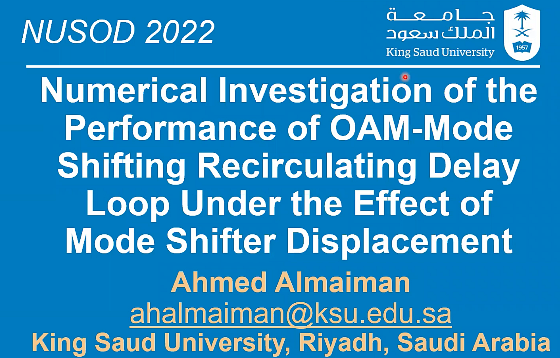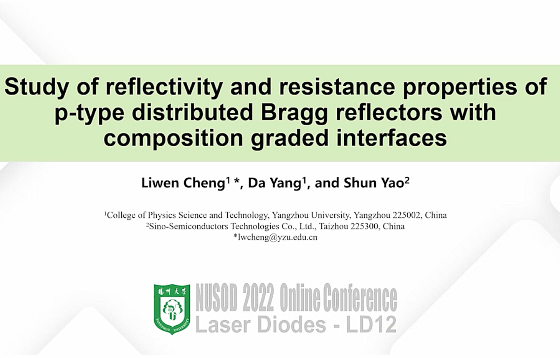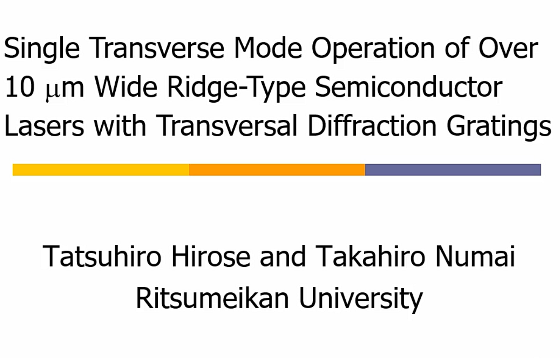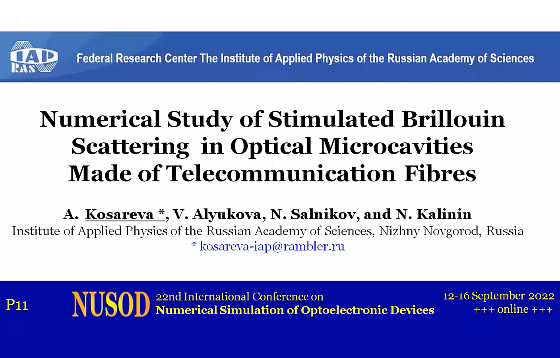Poster61 Videos



We present a tunable planar guided-mode resonance (GMR) filter using time-varying permittivity along grating nanobars. Results show that the effective medium concept in the temporal state is exactly the same as the spatial state. Furthermore, the structure has spatial periodicity to save the resonance peak of the passive GMR in addition to the temporal periodicity […]
P20 – Simulation of Optical Planar Waveguide Sensor for Microplastics Detection in Water
Nowadays, microplastics pollution has become a global concern as it endangers the ecology, marine animals, and cause health threats to human beings. This paper attempted to simulate an optical planar waveguide sensor for microplastics detection in water via Wave Optics Module-COMSOL Multiphysics®. The analyte refractive index was ranged from 1.4800 to 1.5000 RIU, in reference […]
D09 – Analysis of Differential Phase Shift Quantum Key Distribution using single-photon detectors
We investigated the performance of differential phase shift quantum key distribution using InGaAs/InP and Silicon-APD (avalanche photo diode) for generating secure keys, secure communication distance, and bit error rates under the various operating conditions.We compare the quantum bit error rate and the secure key generation rate as a function of communication length.Our simulation results show […]
P15 – Numerical simulation of silicon grating-based plasmonic sensor
This work reports on the application of silicon grating-enabled nanostructure for refractive index sensing application in the near-infrared region. This grating helps in launching the plasmon modes efficiently towards the flat metal film deposited with a thin Al2O3 layer. The normal incidence light is used which can be helpful for its integration with optical fiber. […]
LD13 – Numerical Analysis of Electrically Pumped SiGeSn/GeSn Quantum Well Transistor Laser
The threshold current density of electrically pumped Sn incorporated group IV alloy based transistor laser (TL) is analyzed by proposing and designing a theoretical model for the same. Active region for the lasing action is formed by strain compensated GeSn single quantum well (QW) in the base of the transistor. The threshold current density for […]
P09 – 120° Hybrid for Bimodal Interferometers
An 120° hybrid for bimodal interferometers in the 220 nm silicon-on-insulator technology is presented. Three output signals enable an unambiguous phase detection over a 360°-range as well as a constant sensitivity. The length of the hybrid is only 190 µm with a simulated excess loss of 0.16 dB. Measurements combined with digital signal processing verify […]
P12 – Design and Simulation of Temperature Sensors Based on Thermo-Optical WGM Shifts in Silica and Non-Silica Glass Microcavities
Sensing applications of dielectric microcavities with whispering-gallery modes (WGMs) have been actively studied in the recent years. Here we investigated theoretically temperature microsensors based on different glasses, including common silica glass, as well as special germanate, tungsten-tellurite, arsenic sulfide and arsenic selenide glasses. We developed numerical model describing sensing characteristics of the considered microcavities. We […]
N05 – Effect of Poole-Frenkel emission on electroluminescence in quantum dot light emitting devices with Nickel Oxide layer
Theoretical analysis of hybrid quantum dot-light emitting devices incorporating CdSe/ZnS core/shell quantum dots and Nickel Oxide (NiO) as hole injection layer (HIL) has been carried out in this work. The replacement of organic HIL such as poly(3,4-ethylenedioxythiophene):poly(styrenesulfonate) (PEDOT:PSS) with solution-processed NiO layer has led to enhancement of current density and luminance in the device by […]
IS10 – Modelling and Characterisation of Silicon Waveguides in Photonic Integrated Circuits
Modelling and characterization of basic waveguiding structures in integrated photonics is important due to the large variety of established and emerging technologies used for fabrication. In this contribution we present a modelling and characterization approach for integrated silicon waveguides. We provide waveguide characteristics calculated from eigenmode simulation and optical measurement results.
P06 – Flexible, Process-Aware Compact Model of Effective Index in Silicon Waveguides for Commercial Foundries
We report the performance of a compact model for the effective index of SOI wire waveguides, showing exceptional agreement with simulated effective index and confinement factors. The development of such a model represents a potential pathway toward better modeling of silicon photonic devices in commercial foundry processes.
LD15 – Design Analysis of Linear Graded Quantum barriers in Ultravoilet-C Laser Diodes
We demonstrated ultraviolet laser diode with improved optical and electrical features. By employing linear graded rising aluminium concentration in phases from first quantum barrier to last quantum barrier, the suggested LD design improves internal quantum efficiency (IQE) and output power while minimizing the lasing threshold. The proposed LD increases optical gain while lowering carrier leakage […]
SC04 – Performance Evaluation of Lead-Free Cs2CuSbCl6 Perovskite Solar Cells for > 21.67% Efficiency
This work investigates the performance of Cs2CuSbCl6-based lead-free perovskite solar cells for photovoltaic applications. Cs2CuSbCl6 has a bandgap of 1.7eV and it is a durable and non-toxic material. Cs2CuSbCl6 can absorb more photons and thus obtain high efficiency. This work has been performed using SCAPS-1D software with the focus on optimizing the absorber layer thickness […]
LED03 – RGB LED active region design and optimization with Genetic Evolution Algorithm
Multi-quantum-well (MQW) LED is a complex distributed system with strong interaction between two opposite carrier flows, electrons and holes. For both types of carriers, the carrier injection into each QW depends on transport conditions across the whole active region (AR) and is affected by capture-recombination balance in all active QWs. Multi-color LEDs with different types […]
NM09 – Calculation of intersubband absorption in n-doped BaSnO3 quantum wells
In this work we explore novel and promising BaO/BaSnO3 perovskite-oxide quantum well material system which has recently attracted attention due to its many advantages and possible applications in electronic devices. We focus on calculation of intersubband absorption in La-doped BaSnO3 quantum wells and investigate the tuning of absorption spectra with QW thickness and external electric […]
NM11 – Highly Efficient and Novel Lumped Michelson Modulator using Vertical PN junction based Phase Shifter
Vertical PN depletion phase shifter based novel Common Mirror Michelson Modulator is proposed. It has a lower V, higher ER for a particular value of source impedance at a given bitrate and doping than conventional PN phase shifter based modulator.
IS13 – Design and Performance Analysis of All Optical Half Adder based on Carrier Reservoir SOA -Mach Zehnder Interferometer (MZI) Configuration
In this manuscript, Carrier reservoir SOA (CR-SOA) based half adder is proposed and simulated at 100 Gb/s. CR-SOA has fast carrier recovery, due to presence carrier reservoir which enables its use at higher data rates on the other hand conventional SOA suffers from slow carrier recovery which leads to unequal amplification of pulses. The obtained […]
IS12 – A compact Kerr effect based Plasmonic Logic Device for Nanotechnology Applications
This work utilizes the vital property of Kerr effect of altering the phase of optical signal to numerically investigate the plasmonic XOR/XNOR logic device for nanotechnology applications. Extinction ratio (ER) and insertion loss (IL) of basic switching element (Mach-Zehnder interferometer) is evaluated and plotted as a function of length of interferometric arms. The obtained result […]
NM13-Highly sensitive ring resonator based refractive index sensor for label free biosensing applications
Ring resonator based label free refractive index biosensor is proposed for detecting glucose and hemoglobin concentrations. To improve device sensitivity and Q factor, various parameters of ring resonator are optimized. The designed ring resonator sensor can sense hemoglobin and glucose concentrations with a high sensitivity of 424 nm/RIU and Q factor of 802.
NM14-Mid-infrared optical modulator based on D-shaped PCF
Recently, photonic crystal fibers (PCFs) have become of compelling interest due to their diverse applications, especially in the mid-infrared (mid-IR) wavelength regime. In this work, an optical mid-IR modulator based on D-shaped PCF with germanium-antimony-tellurium (GST) as a phase-changing material (PCM) is presented and analyzed. Because of the phase transition of the GST material between […]
NM08 – Silicon-Based Plasmonic Nanoantennas at midinfrared for Gas Sensing Applications
Advanced nanotechnology especially CMOS technology- enables us to re-design the classic antenna in the nanoscale, which can convert propagating optical wavelengths instead of radio and microwave wavelengths into localized energy and vice versa. As a result, sensors may be designed to make sensing molecules with their characteristic vibrational transitions easier. Bowtie silicon nanoantennas are investigated […]
IS06 – Characteristics of All-Optical Gate Switch Employing Quasi-Phase-Matched Lithium Niobate Devices
We analyze characteristics of all-optical switches using the cascade of second harmonic generation and difference frequency mixing in quasi-phase-matched lithium niobate devices. Numerical calculations consider not only the pulse waveforms but also the optical noises.
SC03 – Simulation and Optimization of Nano-structured Gratings Alternative of Thin-film Anti-Reflectors for GaAs Solar Cells Conversion Efficiency Improvement
Modern civilization demands energy, and the energy demand is increasing almost every day all over the world. The dependency on conventional energy resources including fossil fuel, oil, gas, coal etc. are not in favor of having sustainable global earth. For this reason, renewable or clean energy is one only option while acquiring energy from the […]
D06 – Examination of Resonant Cavity Enhanced Strain Compensated SiGeSn/GeSn Interband MQWIP
In this work, mathematical investigation is done for the potential of Group IV alloy based resonant cavity enhanced interband multiple quantum well photodetector (MQWIP). Strain balanced multiple quantum well structure is proposed to be configured between two Bragg reflectors (mirrors) to form a resonant cavity. Responsivity is calculated by solving the rate equation in each […]
LED09 – Enhanced optoelectronic properties of UV-C light-emitting diode
We numerically analyzed proposed structure named as LED S2 in comparison to reference structure LED S1. In LED S2 we introduced undoped AlGaN and p-AlGaN layers between the electron blocking layer (EBL) and the p-GaN (hole injecting layer). The simulation finding shows proposed structure (LED S2) provide a better strategy for lowering electron overflow and […]
MM11 – The Variations of Photoluminscence Decay Times Under The Influence of A Trapping State
We numerically calculated the time-resolved photoluminescence spectra using the bimolecular trapping-detrapping model. The variations of carrier lifetimes are investigated by changing the carrier recombination and trapping rate constants, as well as the concentration of available trapping states.
IS11 – Numerical Investigation of the Performance of OAM-Mode Shifting Recirculating Delay Loop Under the Effect of Mode Shifter Displacement
We investigate the effect of OAM mode shifter displacement on the performance of the OAM-mode shifting recirculating delay loop by simulating the beam propagation using Kirchhoff-Fresnel diffraction. Simulation results indicate that 20 delayed replicas may be obtained with >10 dB signal-to-crosstalk ratio (SCR) if alignment is perfect and ℓshift=+1
NM15-Performance Optimization of Surface Plasmon Resonance based Sensors from the First Principle
Performance optimization of surface plasmon resonance (SPR) based sensors due to improvement in input optical coupling is theoretically investigated from the first principle. Various design parameters are optimized in a typical prism coupling Kretschmann configuration.
LD12 – Study of reflectivity and resistance properties of p-type distributed Bragg reflectors with composition graded interfaces
In this work, the reflectivity and series resistance of the p-type distributed Bragg reflectors (DBRs) in vertical cavity surface emitting lasers (VCSELs) under the different thickness of composition graded interface layers, Al composition of the high Al composition layers, Al composition of the low Al composition layers, and the number of DBR periods are simulated […]
LD11 – Single Transverse Mode Operation of Over 10 µm Wide Ridge-Type Semiconductor Lasers with Transversal Diffraction Gratings Tatsuhiro Hirose and Takahiro Numai
This paper reports on single transverse mode operation of a ridge-type semiconductor laser with transversal diffraction gratings for a mesa width over 10 µm when the number of periods is 160, the grating pitch is 428.7 nm, and the grating depth is 250 nm.
P11 – Numerical Study of Stimulated Brillouin Scattering in Optical Microcavities Made of Telecommunication Fibres
We numerically studied stimulated Brillouin scattering processes up to the 5th order is microcavities with various realistic diameters and Q-factors made of standard telecommunication fibres. Pump power thresholds were simulated for different parameters of the system. The larger the microcavity and lower Q-factors, the higher pump power thresholds are. It is also shown that thresholds […]

